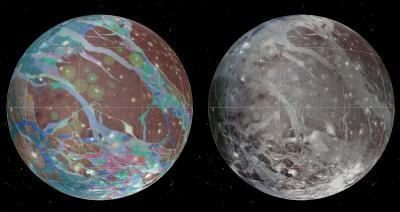The U.S. Geological Survey has gone cosmic and produced the first global geological map of Ganymede, Jupiter's largest moon and the largest in the solar system.
The geologists combined images from the Voyager and Galileo spacecraft to put the map together. Voyager was the first mission to fly through the Jupiter satellite system and passed by the icy surface of Ganymede in 1979. Those first images revealed a complex surface, segmented and fractured into dark and light terrain. In 1995, the Galileo spacecraft was placed in orbit around Jupiter and began to return high-resolution images of the surface that help to understand many of the features seen at low-resolution by Voyager.
No article on other planets is complete without hinting at extraterrestrial life so USGS made certain to note that Ganymede's varied terrain and possible underground ocean make it a prime target in the search for habitable environments in the solar system,.

Using images from NASA's Voyager Mission (1979) and the orbital Galileo Mission (1995), researchers have created the first global geological map of Jupiter's largest moon, Ganymede. Credit: USGS
Jim Head, the Scherck Distinguished Professor of Geological Sciences at Brown University and one of the map's co-authors, was a co-investigator on the Galileo's Solid State Imaging (SSI) experiment. In that role, he and his team were responsible for planning the imaging sequences for Ganymede in order to identify and investigate the scientific targets of highest priority. The team worked for several years to obtain the data necessary to make the global map.
Study leader Geoffrey Collins, professor at Wheaton College in Massachusetts, started looking at the data as a graduate student. Wes Patterson and Louise Prockter of the Johns Hopkins University Applied Physics Laboratory, also started work on the project as graduate students at Brown. Robert Pappalardo, now at NASA's Jet Propulsion Lab, was part of the team during postdoctoral studies at Brown.
"I'm so glad all that work has paid off in the form of this detailed global map," Head said. "It is equally rewarding to see that the Brown team has now moved on to positions of leadership in the planetary exploration research community."






Comments